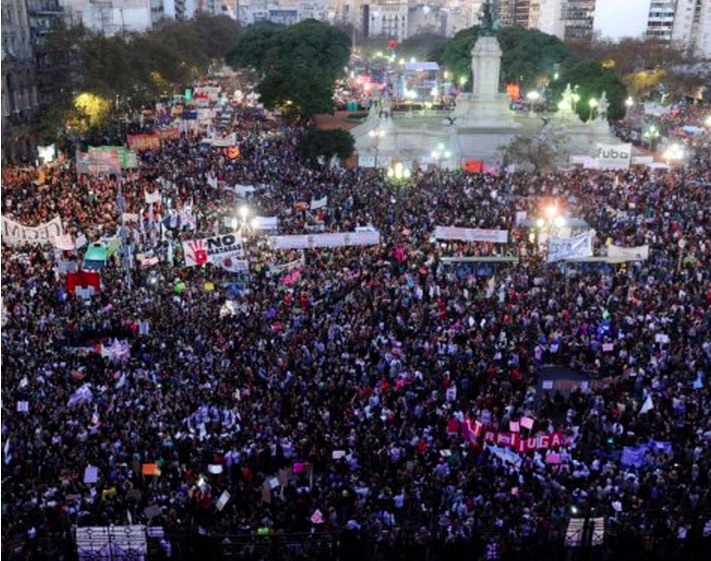. . WOMEN’S EQUALITY . .
An article from Diario La Prensa (translated by CPNN)
The petition circulated within the #NiUnaMenos march against femicide called for “comprehensive” implementation of the law against Gender Violence, enacted in 2009 and regulated a year later. Thousands of people marched today [03.06.2015] in the main cities of the country against the femicide that has taken the life of 277 women and girls in 2014. The main march took place in front of the National Congress where protesters demanded the implementation of the law against gender violence.

click on photo to enlarge
The march in the city of Buenos Aires, led by women’s organizations and a group of actresses, journalists and activists who had made the call on social networking sites with the slogan #NiUnaMenos was also replicated in Uruguay, Chile and Miami.
At he ceremony in the Plaza de los Dos Congresos the noted cartoonist Maitena Burundarena and the actors Juan Minujín and Erica Rivas read a document to be signed by legislators and politicians as a compromise in the implementation of actions to prevent violence gender and femicide. The text highlighted what is missing in the missing in the Law 26.485 against Gender Violence, enacted in 2009, including the establishment of a National Action Plan for the Prevention, Assistance and Eradication of violence against women.
“As it stands the law is insufficient to prevent an increase in gender violence,” said Minujín as part of the reading of the document. He demanded implement of the initiative “with all necessary resources and monitoring”.
Furthermore, they demanded that the victims’ access to justice be guaranteed, that prosecutors and police have staff “trained and qualified to receive complaints”, unification of the civil and criminal jurisdictions, and access by victims to free legal support throughout their process.
Another demand referred to the development of a single official record of victims of violence against women and femicide with official and updated information on statistics, because “only by measuring what happens can allow the design of effective public policies.”
They also requested the guarantee and improvement of comprehensive sex education at all educational levels, “to teach equality and freedom from discrimination and gender violence and to sensitize and train teachers and principals”.
“Ensuring the protection of victims of violence and implementation of electronic monitoring of offenders to ensure they do not violate restrictions, are other demands put forward.
In this context, the text emphasized that “the judiciary is not sufficiently helping victims” who should receive “the contribution of witnesses and evidence” and that the judiciary “does not sufficiently guarantee effective measures” to prevent gender violence.
(click here for the original article in Spanish)
(article continued in right column)
Protecting women and girls against violence, Is progress being made?
(article continued from left column)
“This is institutional violence,” said Minujín, and received applause from the protesters, just as when he said that “many victims have already made allegations”.
The text also referred to women victims of trafficking in persons “whose fate remains unknown. For them also we ask for justice”. There was also reference to the treatment of victims of gender violence in the media.
The event began with a video on gender violence and it included participation by survivors and relatives of victims, who had previously begun to focus on the area and tell their experiences to the media.
Among the posters were “No to violence against women”, “Stop femicide”, “Right to Life” and “For you, Iris, Marcela, killed by femicide”.
One participant said that “for us it is a great triumph of the women’s movement. The state leaves us completely alone” and urged that we unite “together to prevent violence and defend our rights.”
Among the participants were politicians, actors, actresses, activists, journalists, the Madres del Dolor and relatives of the Argentine teenager, Lola Chomnalez, who was murdered in Uruguay.
The mobilization surged on May 12 after the femocides of the pregnant adolescent, Chiara Paez, in the town of Santa Fe Rufino, whose body was found buried in the house of her boyfriend two days before the convening of the march, and the lawyer Gabriela Parra, who was murdered by her former partner in a candy store in the neighborhood of Caballito, on 3 March.
(Thank you to the Good News Agency for alerting us to this event.)